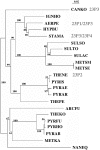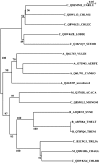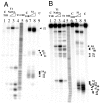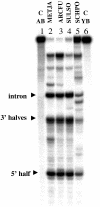Evolution of introns in the archaeal world
- PMID: 21383132
- PMCID: PMC3064391
- DOI: 10.1073/pnas.1100862108
Evolution of introns in the archaeal world
Abstract
The self-splicing group I introns are removed by an autocatalytic mechanism that involves a series of transesterification reactions. They require RNA binding proteins to act as chaperones to correctly fold the RNA into an active intermediate structure in vivo. Pre-tRNA introns in Bacteria and in higher eukaryote plastids are typical examples of self-splicing group I introns. By contrast, two striking features characterize RNA splicing in the archaeal world. First, self-splicing group I introns cannot be found, to this date, in that kingdom. Second, the RNA splicing scenario in Archaea is uniform: All introns, whether in pre-tRNA or elsewhere, are removed by tRNA splicing endonucleases. We suggest that in Archaea, the protein recruited for splicing is the preexisting tRNA splicing endonuclease and that this enzyme, together with the ligase, takes over the task of intron removal in a more efficient fashion than the ribozyme. The extinction of group I introns in Archaea would then be a consequence of recruitment of the tRNA splicing endonuclease. We deal here with comparative genome analysis, focusing specifically on the integration of introns into genes coding for 23S rRNA molecules, and how this newly acquired intron has to be removed to regenerate a functional RNA molecule. We show that all known oligomeric structures of the endonuclease can recognize and cleave a ribosomal intron, even when the endonuclease derives from a strain lacking rRNA introns. The persistence of group I introns in mitochondria and chloroplasts would be explained by the inaccessibility of these introns to the endonuclease.
Conflict of interest statement
The authors declare no conflict of interest.
Figures







Similar articles
-
RNomics in Archaea reveals a further link between splicing of archaeal introns and rRNA processing.Nucleic Acids Res. 2002 Feb 15;30(4):921-30. doi: 10.1093/nar/30.4.921. Nucleic Acids Res. 2002. PMID: 11842103 Free PMC article.
-
Coevolution of tRNA intron motifs and tRNA endonuclease architecture in Archaea.Proc Natl Acad Sci U S A. 2005 Oct 25;102(43):15418-22. doi: 10.1073/pnas.0506750102. Epub 2005 Oct 12. Proc Natl Acad Sci U S A. 2005. PMID: 16221764 Free PMC article.
-
Structural and mutational analysis of tRNA intron-splicing endonuclease from Thermoplasma acidophilum DSM 1728: catalytic mechanism of tRNA intron-splicing endonucleases.J Bacteriol. 2007 Nov;189(22):8339-46. doi: 10.1128/JB.00713-07. Epub 2007 Sep 7. J Bacteriol. 2007. PMID: 17827289 Free PMC article.
-
The natural history of group I introns.Trends Genet. 2005 Feb;21(2):111-9. doi: 10.1016/j.tig.2004.12.007. Trends Genet. 2005. PMID: 15661357 Review.
-
Archaeal introns: splicing, intercellular mobility and evolution.Trends Biochem Sci. 1997 Sep;22(9):326-31. doi: 10.1016/s0968-0004(97)01113-4. Trends Biochem Sci. 1997. PMID: 9301331 Review.
Cited by
-
RNA-Targeting Splicing Modifiers: Drug Development and Screening Assays.Molecules. 2021 Apr 14;26(8):2263. doi: 10.3390/molecules26082263. Molecules. 2021. PMID: 33919699 Free PMC article. Review.
-
Archaeal tRNA-Splicing Endonuclease as an Effector for RNA Recombination and Novel Trans-Splicing Pathways in Eukaryotes.J Fungi (Basel). 2021 Dec 12;7(12):1069. doi: 10.3390/jof7121069. J Fungi (Basel). 2021. PMID: 34947051 Free PMC article.
-
Asgard archaea modulate potential methanogenesis substrates in wetland soil.Nat Commun. 2024 Jul 31;15(1):6384. doi: 10.1038/s41467-024-49872-z. Nat Commun. 2024. PMID: 39085194 Free PMC article.
-
Importance of pre-mRNA splicing and its study tools in plants.Adv Biotechnol (Singap). 2024 Feb 8;2(1):4. doi: 10.1007/s44307-024-00009-9. Adv Biotechnol (Singap). 2024. PMID: 39883322 Free PMC article. Review.
-
Variation of tRNA modifications with and without intron dependency.Front Genet. 2024 Sep 4;15:1460902. doi: 10.3389/fgene.2024.1460902. eCollection 2024. Front Genet. 2024. PMID: 39296543 Free PMC article. Review.
References
-
- Saldanha R, Mohr G, Belfort M, Lambowitz AM. Group I and group II introns. FASEB J. 1993;7:15–24. - PubMed
-
- Cech TR. Self-splicing of group I introns. Annu Rev Biochem. 1990;59:543–568. - PubMed
-
- Grabowski PJ, Seiler SR, Sharp PA. A multicomponent complex is involved in the splicing of messenger RNA precursors. Cell. 1985;42:345–353. - PubMed
-
- Moore MJ, Sharp PA. Evidence for two active sites in the spliceosome provided by stereochemistry of pre-mRNA splicing. Nature. 1993;365:364–368. - PubMed
Publication types
MeSH terms
Substances
LinkOut - more resources
Full Text Sources
Molecular Biology Databases

